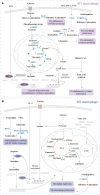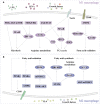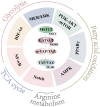The potential role of Hippo pathway regulates cellular metabolism via signaling crosstalk in disease-induced macrophage polarization
- PMID: 38274792
- PMCID: PMC10808647
- DOI: 10.3389/fimmu.2023.1344697
The potential role of Hippo pathway regulates cellular metabolism via signaling crosstalk in disease-induced macrophage polarization
Abstract
Macrophages polarized into distinct phenotypes play vital roles in inflammatory diseases by clearing pathogens, promoting tissue repair, and maintaining homeostasis. Metabolism serves as a fundamental driver in regulating macrophage polarization, and understanding the interplay between macrophage metabolism and polarization is crucial for unraveling the mechanisms underlying inflammatory diseases. The intricate network of cellular signaling pathway plays a pivotal role in modulating macrophage metabolism, and growing evidence indicates that the Hippo pathway emerges as a central player in network of cellular metabolism signaling. This review aims to explore the impact of macrophage metabolism on polarization and summarize the cell signaling pathways that regulate macrophage metabolism in diseases. Specifically, we highlight the pivotal role of the Hippo pathway as a key regulator of cellular metabolism and reveal its potential relationship with metabolism in macrophage polarization.
Keywords: Hippo; inflammatory diseases; macrophage polarization; metabolism; regulatory network.
Copyright © 2024 An, Tan, Yang, Gao and Dong.
Conflict of interest statement
The authors declare that the research was conducted in the absence of any commercial or financial relationships that could be construed as a potential conflict of interest.
Figures





Similar articles
-
Fibroblast growth factor signaling in macrophage polarization: impact on health and diseases.Front Immunol. 2024 Jun 19;15:1390453. doi: 10.3389/fimmu.2024.1390453. eCollection 2024. Front Immunol. 2024. PMID: 38962005 Free PMC article. Review.
-
Regulation of lipid-induced macrophage polarization through modulating peroxisome proliferator-activated receptor-gamma activity affects hepatic lipid metabolism via a Toll-like receptor 4/NF-κB signaling pathway.J Gastroenterol Hepatol. 2020 Nov;35(11):1998-2008. doi: 10.1111/jgh.15025. Epub 2020 Mar 18. J Gastroenterol Hepatol. 2020. PMID: 32128893
-
Regulatory mechanism of macrophage polarization based on Hippo pathway.Front Immunol. 2023 Nov 28;14:1279591. doi: 10.3389/fimmu.2023.1279591. eCollection 2023. Front Immunol. 2023. PMID: 38090595 Free PMC article. Review.
-
Macrophage Polarization: An Important Candidate Regulator for Lung Diseases.Molecules. 2023 Mar 4;28(5):2379. doi: 10.3390/molecules28052379. Molecules. 2023. PMID: 36903624 Free PMC article. Review.
-
The interplay between hippo signaling and mitochondrial metabolism: Implications for cellular homeostasis and disease.Mitochondrion. 2024 May;76:101885. doi: 10.1016/j.mito.2024.101885. Epub 2024 Apr 21. Mitochondrion. 2024. PMID: 38643865 Review.
Cited by
-
Endometriosis-derived exosomes encapsulated miR-196a-5p mediate macrophage polarization through regulation of the Hippo pathway.J Cell Commun Signal. 2025 May 25;19(2):e70020. doi: 10.1002/ccs3.70020. eCollection 2025 Jun. J Cell Commun Signal. 2025. PMID: 40416727 Free PMC article.
-
Atypical Hippo signaling network: uncovering novel insights into head and neck cancer biology and advancements in precision intervention.Front Cell Dev Biol. 2025 May 23;13:1610471. doi: 10.3389/fcell.2025.1610471. eCollection 2025. Front Cell Dev Biol. 2025. PMID: 40486910 Free PMC article. Review.
-
Regulatory Mechanism of Intestinal Stem Cells Based on Hippo Pathway and Signaling Crosstalk in Chicken.Int J Mol Sci. 2025 May 24;26(11):5067. doi: 10.3390/ijms26115067. Int J Mol Sci. 2025. PMID: 40507877 Free PMC article. Review.
-
Interplay of Glucose Metabolism and Hippo Pathway in Chondrocytes: Pathophysiology and Therapeutic Targets.Bioengineering (Basel). 2024 Sep 27;11(10):972. doi: 10.3390/bioengineering11100972. Bioengineering (Basel). 2024. PMID: 39451348 Free PMC article. Review.
References
Publication types
MeSH terms
LinkOut - more resources
Full Text Sources

